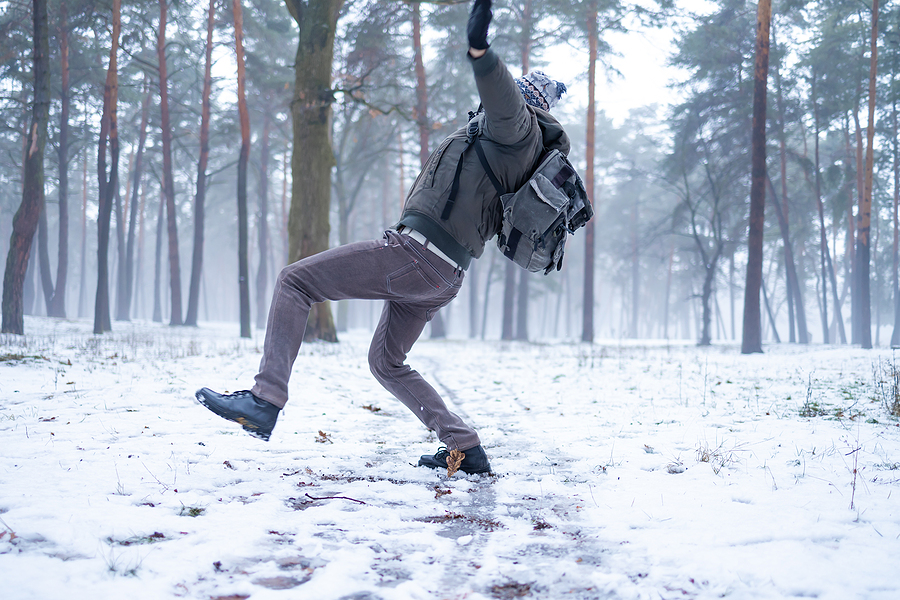Summary
- Common causes of slip and falls include hazardous walking surfaces, wet floors, inadequate signage, etc.
- A property owner or manager’s negligence often contributes to slip and fall accidents.
- A skilled personal injury attorney can prove negligence and help an injury victim obtain maximum compensation.
Movies and television shows often depict slips and falls as being humorous. But there’s nothing funny about suddenly losing your footing and slamming onto a hard surface. In many instances, causes of slip and falls involve negligence from the property owner. When that happens, victims deserve maximum compensation.
Sand Law attorneys have extensive experience in helping victims injured due to negligence on the part of others. We know the common causes of slip and falls and how to hold accountable those whose carelessness leads to harm. Please call 651-291-7263 or contact us online for a free consultation.
Here’s a look at some reasons slip and fall accidents occur and information on how an attorney can help if you’ve been hurt.
Hazardous Walking Surfaces
Uneven or damaged sidewalks, wet or icy floors, and poorly maintained walking areas are among the most common causes of slip and falls. About 1,500-2,000 more falls occur from December through March in Minnesota than any other months due to icy surfaces.
Inadequate lighting in parking lots or walkways can also contribute to a lack of visibility, increasing the likelihood of accidents.
Property owners must maintain safe conditions for visitors. Failure to address issues like cracked sidewalks, uneven flooring, insufficient lighting, or icy surfaces can lead to preventable slip and fall incidents.
Wet or Slippery Floors
Wet or slippery floors easily cause slip and fall accidents, especially in public spaces like supermarkets, restaurants, or shopping malls. Spills that are not promptly cleaned or marked with warning signs can catch unsuspecting individuals off guard. Additionally, freshly mopped or waxed floors without proper warning signs can create hazardous conditions.
Property owners and businesses must promptly address slippery surfaces, whether it be from a spill, leak, or other condition that may make the surface wet and difficult to safely walk on. Negligence in addressing these issues can make them legally liable for injuries sustained on their premises.
Inadequate Signage and Warning
Proper signage and warning indicators are essential for preventing slip and fall accidents. Failing to place warning signs near hazards can contribute to accidents. Courts may consider the absence of adequate warnings to be negligence in premises liability cases.
Lack of Handrails or Guardrails
Staircases and elevated walkways that have a lack of proper handrails or guardrails pose a significant risk of slip and fall accidents. These safety features are crucial for supporting and preventing individuals from losing balance on elevated surfaces.
Property owners must typically install and maintain handrails or guardrails in areas with an elevated risk of falling. Failure to do so may lead to legal liability if someone suffers an injury due to a fall.
Other Forms of Negligence
Negligence is a broad category that encompasses various factors contributing to slip and fall accidents. This includes poorly maintained flooring, loose carpeting, or cluttered walkways.
Regular property maintenance is a fundamental aspect of preventing slip and fall accidents. Neglecting this duty can result in legal consequences if someone is injured due to the property owner’s failure to maintain a safe environment.
How a Personal Injury Attorney Can Help
Personal injury lawyers work to help slip and fall victims obtain compensation from those whose negligence caused their injury. Here’s how skilled slip and fall attorneys help victims in the aftermath of this type of incident.
Proving Negligence
An attorney must gather evidence of a slip and fall to prove the negligence of a property owner when pursuing compensation for the case. They must prove the negligence directly led to the victim’s injuries.
An attorney does this by presenting evidence, witness testimony, and, if necessary, expert opinions to establish a clear link between the property owner’s actions or omissions and the accident.
Establishing Liability
A key aspect of pursuing compensation is establishing liability. Attorneys gather evidence, such as photographs, witness statements, and documentation of property conditions, to demonstrate that the property owner was negligent in maintaining safe premises. Establishing liability is essential for building a solid case for compensation.
Calculating Damages
Personal injury lawyers work to quantify the victim’s damages. This includes economic damages such as medical expenses, lost wages, and property damage, and non-economic damages like pain and suffering, emotional distress, and loss of enjoyment of life. Accurately calculating damages is crucial for ensuring victims receive fair compensation for their losses.
Negotiating with Insurance Companies
Lawyers often seek compensation through the insurance company covering the property or business owner. Personal injury attorneys handle negotiations with insurance companies on behalf of the victim to avoid an insurance company providing inadequate compensation. They employ their significant negotiation skills to secure a fair settlement that adequately addresses the victim’s damages.
Filing a Lawsuit and Legal Representation
If the insurance company fails to offer a fair settlement, slip and fall lawyers must go to court to help their clients obtain compensation. Even though 96-97% of personal injury cases settle, a good attorney will always be prepared for a trial.
If this happens in your case, your lawyer will fight for your rights in court. They’ll be prepared to counter any arguments the defendant may make to escape liability.
Providing Guidance and Support
Throughout the legal process, personal injury attorneys guide and support their clients. They explain legal procedures, answer questions, and address concerns to ensure victims feel at ease.
This support is crucial in alleviating the stress and uncertainty that often accompany legal proceedings.
Speak With a Sand Law Attorney to Learn More
A Sand Law attorney is standing by to help if you suffered an injury because a negligent property owner contributed to one of the causes of slip and falls mentioned above. Please schedule a free case review by using our online form or calling 651-291-7263.
Frequently Asked Questions
Can weather conditions alone be grounds for a slip-and-fall lawsuit?
Adverse weather conditions such as rain, snow, or ice can be grounds for a slip and fall lawsuit if the property owner fails to implement proper snow and ice removal procedures. While property owners cannot control the weather, they are responsible for maintaining safe conditions for pedestrians.
How do attorneys establish liability in slip-and-fall cases involving inadequate signage?
Attorneys establish liability in these cases by gathering evidence such as photographs, witness statements, and documentation of property conditions. If a property owner fails to place warning signs near potential hazards, and this failure contributes to a slip and fall incident, they may face liability.
How do personal injury attorneys handle negotiations with insurance companies?
Personal injury attorneys assess the victim’s damages, including economic and non-economic factors, and calculate a fair compensation amount. They then present a compelling case to the insurance adjuster, emphasizing the strength of the evidence gathered. The goal is to secure a fair settlement that adequately addresses the victim’s damages without needing a trial.


